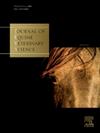Examining equine anthelmintic efficacy using modified procedures
IF 1.6
3区 农林科学
Q2 VETERINARY SCIENCES
引用次数: 0
Abstract
With increasing evidence of anthelmintic resistance in the luminal stages of equine cyathostomins, the need to examine efficacy against encysted stages has risen. Encysted burdens are traditionally evaluated using mucosal digestion, wherein a 5% subsample of intestinal mucosa is processed and digested for enumeration. In the standard protocol, a single 2% aliquot of this subsample is counted for early third stage (EL3) and late third stage/mucosal fourth stage (LL3/L4) larvae. The first study investigated precision of larval counts from both the current gold standard procedure and a modified protocol where all larvae from the 5% tissue subsample were counted. In spring 2024, 12 untreated juvenile horses naturally infected with cyathostomins were enrolled, and triplicate 5% mucosal samples were collected from the cecum, ventral colon, and dorsal colon. For each sample, the standard 2% aliquot was counted as well as the remaining 5% tissue aliquot. Mixed models were constructed for counts, measuring proportion of variation for each fixed effect. Coefficients of variation (CV) were calculated to evaluate precision. The mean CV for the subsample (2%) and total (100%) counts by stage were as follows: EL3 (subsample) 100.7%, (total) 59.0%; L3/L4 (subsample) 112.7%, (total) 82.2%; total larvae (subsample) 85.7%, (total) 23.7%. Precision difference by aliquot amount varied significantly (P < 0.001). All fixed effects—foal, larval stage, aliquot size (P < 0 0.001), and organ (P = 0.003)—were statistically significant and contributed significant proportions of count variance; however, aliquot size (2% or 100%) provided the most (57.5%). These results suggest the standard mucosal digestion technique using the 2% count is nonrepresentative of overall larval burden and highly imprecise, warranting further investigation into how procedure can affect interpretation of data, particularly in the context of anthelmintic efficacy studies.
使用改良程序检查马驱虫功效
随着越来越多的证据表明马胞口毒素在腔内阶段具有驱虫耐药性,研究对囊内阶段的有效性的必要性已经上升。传统上使用粘膜消化法评估囊性负担,其中处理和消化5%的肠粘膜亚样本以进行计数。在标准方案中,该子样本的2%用于早期第三期(EL3)和晚期第三期/粘膜第四期(LL3/L4)幼虫的计数。第一项研究调查了当前金标准程序和修改后的方案中幼虫计数的准确性,其中5%组织亚样本中的所有幼虫都被计数。在2024年春季,研究人员招募了12匹未经治疗的天然感染cyathostomins的幼年马,并从盲肠、腹结肠和背结肠收集了三份5%的粘膜样本。对于每个样品,计算标准的2%的同分物以及剩余的5%的组织同分物。为计数构建混合模型,测量每个固定效应的变异比例。计算变异系数(CV)来评价其精度。分阶段子样本(2%)和总(100%)计数的平均CV如下:EL3(子样本)100.7%,(总)59.0%;L3/L4(子样本)112.7%,(总样本)82.2%;总幼虫(子样)85.7%,总幼虫(总)23.7%。等量精密度差差异显著(P <;0.001)。所有固定效应-马驹,幼虫期,大小相等(P <;0 0.001)和器官(P = 0.003)-有统计学意义,并贡献了显著比例的计数方差;然而,相同大小(2%或100%)提供了最多(57.5%)。这些结果表明,使用2%计数的标准粘膜消化技术不具有总体幼虫负荷的代表性,并且高度不精确,需要进一步调查程序如何影响数据的解释,特别是在驱虫功效研究的背景下。
本文章由计算机程序翻译,如有差异,请以英文原文为准。
求助全文
约1分钟内获得全文
求助全文
来源期刊

Journal of Equine Veterinary Science
农林科学-兽医学
CiteScore
2.70
自引率
7.70%
发文量
249
审稿时长
77 days
期刊介绍:
Journal of Equine Veterinary Science (JEVS) is an international publication designed for the practicing equine veterinarian, equine researcher, and other equine health care specialist. Published monthly, each issue of JEVS includes original research, reviews, case reports, short communications, and clinical techniques from leaders in the equine veterinary field, covering such topics as laminitis, reproduction, infectious disease, parasitology, behavior, podology, internal medicine, surgery and nutrition.
 求助内容:
求助内容: 应助结果提醒方式:
应助结果提醒方式:


